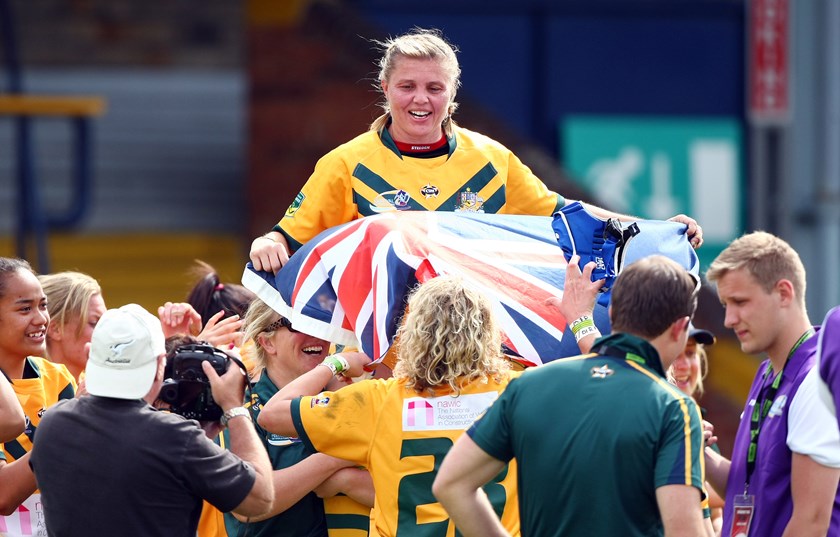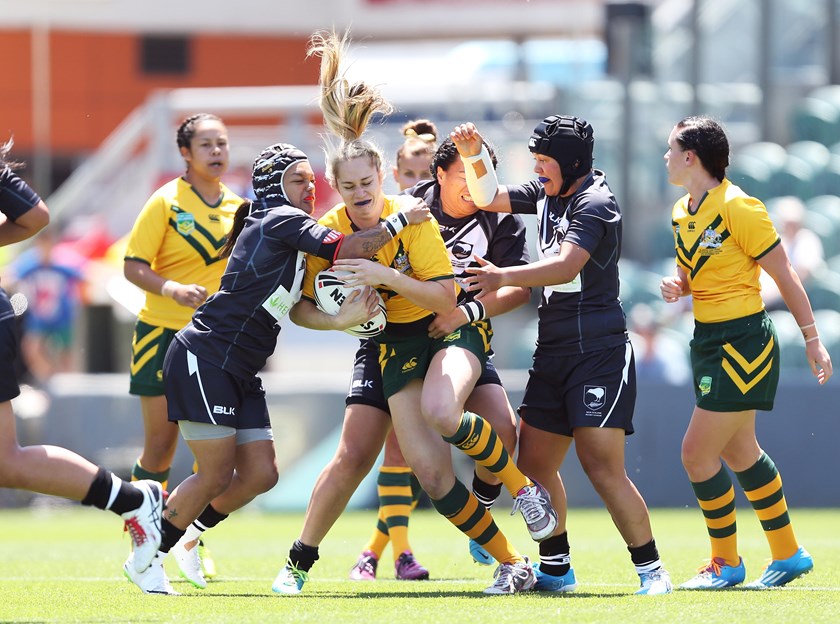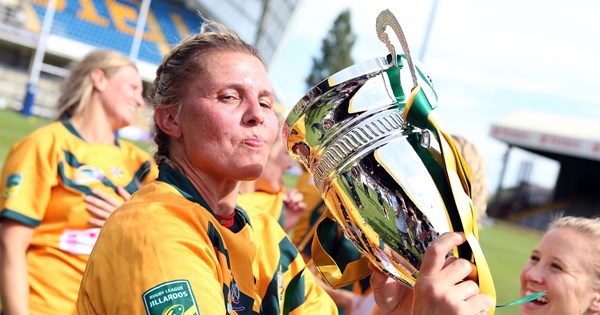As the Jillaroos prepare to celebrate 30 years since their first Test, NRL.com is shining the spotlight on some of the unheralded players who played a key role in the rise of women’s rugby league. This week in our Jillaroos Journey series is Jillaroo No.116 Julie Ariel.
Julie Ariel (nee Young) watched women’s rugby league change right before her eyes.
The former Jillaroo was an amateur when she made her Test debut in 2011.
By 2013, the NRL had stepped in to cover the side’s expenses for the first time at the World Cup in England.
Just 12 months later, Australian women’s players were paid to represent their country for the first time when they took on New Zealand in Wollongong.
599″, “>809”, “>959″]”
data-eqio-prefix=”video-post-screen”
ref=”root”
>
Up Next
/
Replay
Play Next
Australian Jillaroos Top Tries from the Pacific Championships
It was both a long-time coming and a rapid evolution for the women’s game.
“We went from nothing to getting paid in the space of a few years,” Ariel told NRL.com. “We had to fundraise for the Samoa tour, to then have flights and accommodation given to us for the World Cup and even receiving some pay in 2014.
“It wasn’t a massive amount but that’s not the point. It’s a change I was able to be part of in those three campaigns. We went from one to the other and it was a really exciting time.”
When you track the trajectory of the Jillaroos from their inaugural Test in 1995 to their current status as world champions, there is no single turning point.
There are, however, multiple crucial moments that turned out to be pivotal to the sport’s growth.
The first Test was where it all began. The 1999 win over New Zealand gave a new generation hope of what was possible. The drought-breaking victory 10 years later laid the foundation for the 2013 World Cup.
That was the tournament where the snowball started gathering pace and women’s rugby league started an unstoppable rise.
“I remember vividly at the 2013 World Cup sitting in the crowd with David Smith, the NRL CEO at the time, watching the New Zealand v England game,” Tahnee Norris recalls.
“He was talking about how good a game it was and we said ‘mate, you’re the one that can change everything’. He said ‘go and win the World Cup and we’ll see what we can do.’
“So we went and won the World Cup. Coming back from that tournament was massive. We were paraded at the grand final and there was a big change in respect. The game just grew from there and we finally got the NRLW up and running in 2018. That World Cup was a massive catalyst for the growth that we’ve seen now.”
While the Jillaroos were pushing for more support from rugby league authorities, Ariel was tackling her own personal battle.
The hooker tore her ACL in 2012 and was given little hope of returning in time for the World Cup.
Ariel, however, was not going to lay down easily and spent thousands of dollars on medical expenses to give herself a chance to prove she deserved to be on the plane to England.
In the end, it all came down to the 2013 Interstate Challenge.
“I did my ACL in July the year before and my first game back was the Interstate Challenge in April,” Ariel said. “I had to play hooker and prove I could still be able to compete and make the Jillaroos squad.
“Even though I had played for the Jillaroos before, having that injury made some people wonder if I’d ever be able to play again.
“I did my injury in July (2012), had my operation in August, played my first game in April and then we went to England in July so it was a crazy 12 months. I felt like I’d already ticked a box just making the squad.
“It’s hard to explain the feelings after we won the final. There were so many things we had achieved and there had been so many ups and downs in that 12 months so to be in that position was amazing.”
After proving her fitness, Ariel was selected in the Jillaroos squad alongside her sister Emma Young and sister-in-law Rebecca.
599″, “>809”, “>959″]”
data-eqio-prefix=”video-post-screen”
ref=”root”
>
Up Next
/
Replay
Play Next
2024 Hall of Fame Induction – Karyn Murphy
The Australian team was a mix of old and new, with Jillaroo No.1 Nat Dwyer and NRL Hall of Famer Karyn Murphy returning to the fold to lead the next generation of stars.
Sam Bremner, Ruan Sims and Emma Verran all made their debuts in 2013, as did teenage-star Jenni-Sue Hoepper. The tournament also marked the first time the side wore the gold jerseys they currently wear.
Paul Dyer stepped in as coach, with Graham Murray unable to travel to England due to illness. Tragically, the premiership-winning coach passed away just a couple of weeks after the tournament.
The Jillaroos fell to New Zealand in the group stage but wins over England and France were enough to secure a rematch with the Kiwi Ferns in the final.

Karyn Murphy returned to lead the Jillaroos to a historic World Cup victory in 2013.
Hoepper, then just 18 years old, starred as Australia claimed a 22-12 victory at Headingley to secure a historic maiden World Cup.
While she had just burst on to the scene, the centre was aware of what it meant for the senior players in the squad.
“They were the players who were around for a long time and had made a lot of sacrifices,” Hoepper said. “They paved the way for us and to be able to go over there and get the win in the final was amazing.
“I still remember it like it was yesterday. All those little moments of being in camp and being able to do it for those ladies who had gone before us.
“We set a new benchmark that year winning that tournament. It set us up and put us on the map. The rugby league community was able to see us after that. Growing up in Cairns I didn’t know anything about the Jillaroos but that shifted after the World Cup.”
Upon returning home with the trophy in tow, the players instantly noticed a shift. Smith was true to his word and increased the NRL’s investment in women’s rugby league.
The increase was across the board, from the pathways to the elite level. Australian players were paid for the first time in 2014, when the Kiwi Ferns defeated the Jillaroos 12-8 at WIN Stadium.
The match turned out to be Ariel’s last, while it also marked the start of a new generation of players eager to build on the foundation that had been laid.
Kezie Apps, Simaima Taufa and Maddie Studdon were among the youngsters to make their debut on that afternoon.

Jillaroos co-captain Kezie Apps made her international debut in 2014.
For current co-captain Ali Brigginshaw, the change in respect from the wider rugby league community was immediate.
That, she said, was the catalyst for the rapid rise that has followed throughout the past decade.
“The World Cup completely changed the sport,” Brigginshaw said. “In the early days I was ashamed to tell people I played for Australia because of the criticism we’d cop.
“We trained our butts off for the 2013 World Cup, then we won it and proved to everyone we weren’t there to mess around. I was proud to play for Australia, do something that had never been done before and to talk about it.
“That changed the way women’s rugby league was talked about in Australia. People started taking us seriously, people wanted to make the team. We could have the best team now, rather than who could afford it. It was picked purely on talent and we’ve continued growing ever since.”

